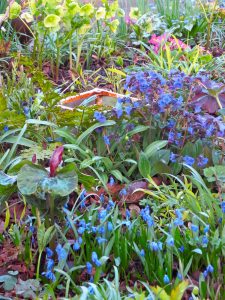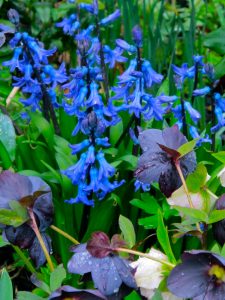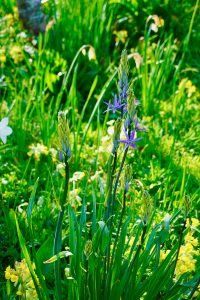I used to live in a wonderful village in Oxfordshire, Hook Norton. One of my great friends, gone and sadly missed, was a farmer who was born and bred there. At this time of year David used to say, “spring is just around the corner Val. The trouble is it’s a bl***y long corner.” This year’s corner has been bloodier away than usual, because March has delivered some really wintry weather this year. This isn’t that unusual, after all country-bred people bang on about the blackthorn winter. Those bitter days, when the icy white blossom of the sloe sends a shudder down the spine.
However, it has seemed worse this year, because we had such a balmy January and early February! Our plants have suffered from the extremes, no doubt about it, but I’m still expecting a wave of blue flowers at Spring Cottage to liven up April and early May. True-blue is such an important colour, because it glows in evening light and I think it’s a great shame that most open gardens aren’t open in the evenings when the light flatters the planting. Still, we gardeners get to stroll about in our own patch once the gloaming descends.

My blue wave (and I’m not talking about a pensioner’s hairdo here) begins with Scilla siberica, commonly called Siberian squill. This miniature bulb is one of those ‘cheap as chips’ bulbs to use a Jamie ‘Oliverism’, although I don’t think anything’s that cheap these days. And certainly not chips. This blue bulb is extremely hardy, as the Siberian epithet suggests. It will flower in shadier conditions, mingling among woodlanders and hellebores for instance. The well-behaved foliage is a pleasing vivid-green and, as soon as it appears in March, you can see the bright-blue bud lurking, waiting for the first clement day. I’m waiting as well.
Once in flower, the bees dance attendance and seeds are set so this is a bulb that spreads by self-seeding. Most species bulbs, with two Latin names such as Scilla siberica or Narcissus cylamineus, spread by producing seeds rather than bulbils. Don’t throw up your hands in horror at this stage, please. The best gardeners are not control freaks. Plants that spread about create waves of colour and fill the gaps. Some of course, go too far and become a nuisance. Its close cousin, Scilla bifolia, is one such plant and I wish I’d never planted it. I have compared the round, wrinkled seed pods to gonads. Enough said. Stop right there, Val.

Generally, I adore bounteous plants that place themselves. I have a sprinkling of S. siberica creeping through several yellow hellebores and it brings them to life, for blues and purples are terrific with oranges and yellows. They sit at opposite sides of the colour wheel, so they provide a dynamic duo. Red and green create the same whoosh of vivid colour. Adjacent colours, whether it’s a range of greens with yellows or reds with oranges and yellows, create a restful but somewhat bland combination. That’s code for dull, dull, dull in my book. I’m with the late Christopher Lloyd on that: he wanted to be excited by his garden. Me too.
The blue scilla wave lasts for three weeks or so, but other plants take over. Pulmonaria ‘Blue Ensign’ has nautical-blue flowers and plain-green foliage rather than the usual spotted and dappled leaves. It’s a jaunty plant, but it must nbe divided every three or so years. It overlaps with the squill in many years and a self-seeding Bowles’s golden grass, Milium effusum ‘Aureum’, adds the touch of sunlight to the woodland carpet. This beaded grass, which creates a glistening veil by May, provides golden foliage right through winter. Weed it out then, if it’s decided to invade your prized hellebore or some such. Allow some to seed though. I also love blue hepaticas, close relatives of wood anemones, for their simple flowers and stamen-rich middles. Lime-green and yellow hellebores will also highlight your blues.
The hepatica ‘Harvington Beauty’ has larger, single-blue flowers that catch the spring raindrops. It was named by Hugh Nunn, a plant breeder who produced the Harvington strain of hybrid hellebores. He moved to Harvington near Evesham and this unnamed hepatica was growing in several village gardens, but no one knew its name. Hugh rescued some from a house about to be redeveloped and he christened it ‘Harvington Beauty’. Debate rages about its Latin species name. It doesn’t set seed, which suggests it’s a hybrid to me, so I will go with H. x media rather than H. transsilvanica. Ashwood Nurseries, who do mail order as well as on-site sales, are the place to get the true plant – www.ashwoodnurseries.com Always phone for availability.

I confess. I have too many hellebores, although they haven’t make much of an appearance this March! Christopher Lloyd, yes that man again, used to call us helle-bores – probably to provoke a reaction. I try to buy paler hellebores, the pastel-pinks, yellows, woodpecker greens and ivory whites, because they shine in the garden. Occasionally I have been seduced by soot-black flowers and they make little impact on the eye in a woodland border unless you can provide a backdrop. I use rich-blue hyacinths, replanted after they’ve been in the house, with sultry hellebores.
When the grass begins to grow the camassias arrive and their numbers are boosted by seedlings, because I don’t deadhead them. Pots may be available now, but the easiest way to establish them is to buy some bulbs in August and plant them in autumn. You don’t have to buy expensive camassias for naturalising. However, they do come in different heights and colours, although the blues always make the strongest plants. Shorter plants flower first and this a general rule of thumb.

The deepest-blue flowers belong to C. quamash and they appear between April and May, but the flowering spikes only reach a foot a height. The indigo six-petalled flowers are asymmetrical. One petal always points straight down whilst the other five form a radiating arc. The upside is, they flower for at least four weeks in most years, nestling into the grass rather than rising above it. C. cusickii is taller, roughly two feet tall, but the flower spike contains a hundred starry flowers. If you want a tall elegant flowering spike, opt for C. leichtlinii, because this will rise above the grass and reach roughly one metre in height or 39 inches. This species, named after Maximilian Leichtlin (1831- 1910), the founder of Baden Baden’s botanic garden, is found in damp mountain meadows in western USA.
These large bulbs do best when planted 6 – 8 inches deep, so this is a spade job unsuited to a wrist-wrenching bulb planter. Camassias like moisture and a cool root run, so mine carpet an area under apple trees. They almost certainly hybridise because seedlings differ. Peter Nyssen – www.peternyssen.com supply reasonably priced bulbs in autumn.
Once summer comes, true-blue flowers are in much shorter supply, with one exception of Campanula lactiflora ‘Prichard’s Variety’. Beth Chatto’s nursery have the true form of this metre-high bellflower. The foliage is green and the flowers are Cadbury milk-foil blue. They form a loose mound at the top and, if deadheaded after the first bellflower flourish is over, they produce more flowers for the next three to four weeks. This perennial is superb among roses, because it fills the gap between the first and second flushes of repeat-flowering roses. It has a definitive life span though, going woody after four to five years. Take one or two cuttings once the new shoots have reached 3 – 3 inches. They will root easily in damp coarse sand.
You’ll get a good infusion of dark-blue form an agapanthus named ‘Alan Street’, the only deep-blue agapanthus that’s generous with its flowers. Rather as Alan was, another friend passed on. Get it from Avon Bulbs – www.avonbulbs.co.uk. I also appreciate the aster named ‘Little Carlow’ for its burning bush of small true-blue stars. It seems to be listed under Symphyotrichum. The September light really flatters the tiny blue flowers and I always hope that it will coincide with the late orange pokers of Kniphofia rooperi. Let’s hope this cold March hasn’t done for my poker! Time will tell.



